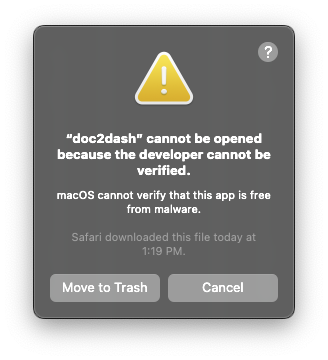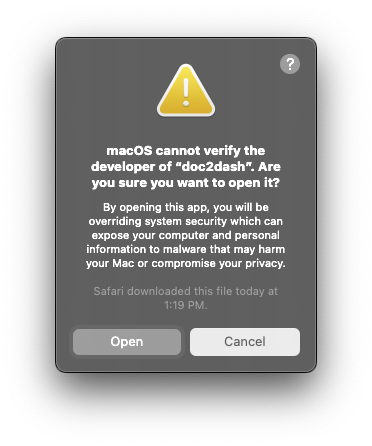One of the perennial talking points in the Python packaging discourse is that it’s unnecessarily difficult to create a simple, single-file binary that you can hand to users.
This complaint is understandable. In most other programming languages, the first thing you sit down to do is to invoke the compiler, get an executable, and run it. Other, more recently created programming languages — particularly Go and Rust — have really excellent toolchains for doing this which eliminate a lot of classes of error during that build-and-run process. A single, dependency-free, binary executable file that you can run is an eminently comprehensible artifact, an obvious endpoint for “packaging” as an endeavor.
While Rust and Go are producing these artifacts as effectively their only output, Python has such a dizzying array of tooling complexity that even attempting to describe “the problem” takes many thousands of words and one may not ever even get around to fully describing the complexity of the issues involved in the course of those words. All the more understandable, then, that we should urgently add this functionality to Python.
A programmer might see Python produce wheels and virtualenvs which can break when anything in their environment changes, and see the complexity of that situation. Then, they see Rust produce a statically-linked executable which “just works”, and they see its toolchain simplicity. I agree that this shouldn’t be so hard, and some of the architectural decisions that make this difficult in Python are indeed unfortunate.
But then, I think, our hypothetical programmer gets confused. They think that Rust is simple because it produces an executable, and they think Python’s complexity comes from all the packaging standards and tools. But this is not entirely true.
Python’s packaging complexity, and indeed some of those packaging standards, arises from the fact that it is often used as a glue language. Packaging pure Python is really not all that hard. And although the tools aren’t included with the language and the DX isn’t as smooth, even packaging pure Python into a single-file executable is pretty trivial.
But almost nobody wants to package a single pure-python script. The whole reason you’re writing in Python is because you want to rely on an enormous ecosystem of libraries, and some low but critical percentage of those libraries include things like their own statically-linked copies of OpenSSL or a few megabytes of FORTRAN code with its own extremely finicky build system you don’t want to have to interact with.
When you look aside to other ecosystems, while Python still definitely has some unique challenges, shipping Rust with a ton of FFI, or Go with a bunch of Cgo is substantially more complex than the default out-of-the-box single-file “it just works” executable you get at the start.1
Still, all things being equal, I think single-file executable builds would be
nice for Python to have as a building block. It’s certainly easier to produce
a package for a platform if your starting point is that you have a
known-good, functioning single-file executable and you all you need to do is
embed it in some kind of environment-specific envelope. Certainly if what you
want is to copy a simple microservice executable into a container image, you
might really want to have this rather than setting up what is functionally a
full Python development environment in your Dockerfile. After team-wide
philosophical debates over what virtual environment manager to use, those
Golang Dockerfiles that seem to be nothing but the following 4 lines are
really appealing:
1 2 3 4 | |
All things are rarely equal, however.
The issue that we, as a community, ought to be trying to address with build tools is to get the software into users’ hands, not to produce a specific file format. In my opinion, single-file binary builds are not a great tool for this. They’re fundamentally not how people, even quite tech-savvy programming people, find and manage their tools.
A brief summary of the problems with single-file distributions:
- They’re not discoverable. A single file linked on your website will not be
found via something like
brew search,apt search,choco searchor searching in a platform’s GUI app store’s search bar. - They’re not updatable. People expect their system package manager to update stuff for them. Standalone binaries might add their own updaters, but now you’re shipping a whole software-update system inside your binary. More likely, it’ll go stale forever while better-packaged software will be updated and managed properly.
- They have trouble packaging resources. Once you’ve got your code stuffed into a binary, how do you distribute images, configuration files, or other data resources along with it? This isn’t impossible to solve, but in other programming languages which do have a great single-file binary story, this problem is typically solved by third party tooling which, while it might work fine, will still generally exist in multiple alternative forms which adds its own complexity.
So while it might be a useful building-block that simplifies those annoying container builds a lot, it hardly solves the problem comprehensively.
If we were to build a big new tool, the tool we need is something that standardizes the input format to produce a variety of different complex, multi-file output formats, including things like:
- deb packages (including uploading to PPA archives so people can add an apt
line; a manual
dpkg -ihas many of the same issues as a single file) - container images (including the upload to a registry so that people can
"$(shuf -n 1 -e nerdctl docker podman)" pullorFROMit) - Flatpak apps
- Snaps
- macOS apps
- Microsoft store apps
- MSI installers
- Chocolatey / NuGet packages
- Homebrew formulae
In other words, ask yourself, as a user of an application, how do you want to consume it? It depends what kind of tool it is, and there is no one-size-fits-all answer.
In any software ecosystem, if a feature is a building block which doesn’t fully solve the problem, that is an issue with the feature, but in many cases, that’s fine. We need lots of building blocks to get to full solutions. This is the story of open source.
However, if I had to take a crack at summing up the infinite-headed hydra of the Problem With Python Packaging, I’d put it like this:
Python has a wide array of tools which can be used to package your Python code for almost any platform, in almost any form, if you are sufficiently determined. The problem is that the end-to-end experience of shipping an application to end users who are not Python programmers2 for any particular platform has a terrible user experience. What we need are more holistic solutions, not more building blocks.3
This makes me want to push back against this tendency whenever I see it, and to try to point towards more efficient ways to achieving a good user experience, with the relatively scarce community resources at our collective disposal4. Efficiency isn’t exclusively about ideal outcomes, though; it’s the optimization a cost/benefit ratio. In terms of benefits, it’s relatively low, as I hope I’ve shown above.
Building a tool that makes arbitrary Python code into a fully self-contained
executable is also very high-cost, in terms of community effort, for a bunch of
reasons. For starters, in any moderately-large collection of popular
dependencies from PyPI, at least a few of them are going to want to find their
own resources via __file__, and you need to hack in a way to find those,
which is itself error prone. Python also expects dynamic linking in a lot of
places, and messing around with C linkers to change that around is a complex
process with its own huge pile of failure modes. You need to do this on
pre-existing binaries built with options you can’t necessarily control,
because making everyone rebuild all the binary wheels they find on PyPI is a
huge step backwards in terms of exposing app developers to confusing
infrastructure complexity.
Now, none of this is impossible. There are even existing
tools to do some of the
scarier low-level parts of these
problems. But one of the reasons that all the existing tools for doing similar
things have folk-wisdom reputations and even official
documentation
expecting constant pain is that part of the project here is conducting a full
audit of every usage of __file__ on PyPI and replacing it with some
resource-locating API which we haven’t even got a mature version of yet5.
Whereas copying all the files into the right spots in an archive file that can be directly deployed to an existing platform is tedious, but only moderately challenging. It usually doesn’t involve fundamentally changing how the code being packaged works, only where it is placed.
To the extent that we have a choice between “make it easy to produce a single-file binary without needing to understand the complexities of binaries” or “make it easy to produce a Homebrew formula / Flatpak build / etc without the user needing to understand Homebrew / Flatpak / etc”, we should always choose the latter.
If this is giving you déjà vu, I’ve gestured at this general concept more vaguely in a few places, including tweeting6 about it in 2019, saying vaguely similar stuff:
If you're making a packaging tool for Python, stop trying to make single-file executables. They are a pointless technical flourish. You need to build:
— glyph ⎷⃣ (@glyph) August 5, 2019
• .app bundles
• .deb/.rpm/flatpack packages
• container images
• .msi installers
• Homebrew formulæ
• a codesigning pipeline
Everything I’ve written here so far is debatable.
You can find that debate both in replies to that original tweet and in various other comments and posts elsewhere that I’ve grumbled about this. I still don’t agree with that criticism, but there are very clever people working on complex tools which are slowly gaining popularity and might be making the overall packaging situation better.
So while I think we should in general direct efforts more towards integrating with full-featured packaging standards, I don’t want to yuck anybody’s yum when it comes to producing clean single-file executables in general. If you want to build that tool and it turns out to be a more useful building block than I’m giving it credit for, knock yourself out.
However, in addition to having a comprehensive write-up of my previously-stated opinions here, I want to impart a more concrete, less debatable issue. To wit: single-file executables as a distribution mechanism, specifically on macOS is not only sub-optimal, but a complete waste of time.
Late last year, Hynek wrote a great post about his desire for, and experience of, packaging a single-file binary for multiple platforms. This should serve as an illustrative example of my point here. I don’t want to pick on Hynek. Prominent Python programmers wish for this all the time.. In fact, Hynek also did the thing I said is a good idea here, and did, in fact, create a Homebrew tap, and that’s the one the README recommends.
So since he kindly supplied a perfect case-study of the contrasting options, let’s contrast them!
The first thing I notice is that the Homebrew version is Apple Silicon native,
whereas the single-file binary is still x86_64, as the brew build and test
infrastructure apparently deals with architectural differences (probably pretty
easy given it can use Homebrew’s existing Python build) but the more
hand-rolled PyOxidizer
setup
builds only for the host platform, which in this case is still an Intel mac
thanks to GitHub dragging their feet.
The second is that the Homebrew version runs as I expect it to. I run
doc2dash in my terminal and I see Usage: doc2dash [OPTIONS] SOURCE, as I
should.
So, A+ on the Homebrew tap. No notes. I did not have to know anything about Python being in the loop at all here, it “just works” like every Ruby, Clojure, Rust, or Go tool I’ve installed with the same toolchain.
Over to the single-file brew-less version.
Beyond the architecture being emulated and having to download Rosetta28, I
have to note that this “single file” binary already comes in a zip file, since
it needs to include the license in a separate file.7 Now that it’s
unarchived, I have some choices to make about where to put it on my $PATH.
But let’s ignore that for now and focus on the experience of running it. I
fire up a terminal, and run cd Downloads/doc2dash.x86_64-apple-darwin/ and
then ./doc2dash.
Now we hit the more intractable problem:

The executable does not launch because it is neither code-signed nor notarized. I’m not going to go through the actual demonstration here, because you already know how annoying this is, and also, you can’t actually do it.
Code-signing is more or less fine. The codesign tool will do its thing, and
that will change the wording in the angry dialog box from something about an
“unidentified developer” to being “unable to check for malware”, which is not
much of a help. You still need to notarize it, and notarization can’t work.
macOS really wants your executable code to be in a bundle (i.e., an App) so
that it can know various things about its provenance and structure. CLI tools
are expected to be in the operating system, or managed by a tool like brew
that acts like a sort of bootleg secondary operating-system-ish thing and knows
how to manage binaries.
If it isn’t in a bundle, then it needs to be in a platform-specific .pkg
file, which is installed with the built-in Installer app. This is because
apple cannot notarize a stand-alone binary executable file.
Part of the notarization process involves stapling an external “notarization
ticket” to your code, and if you’ve only got a single file, it has nowhere to
put that ticket. You can’t even submit a stand-alone binary; you have to
package it in a format that is legible to Apple’s notarization service, which
for a pure-CLI tool, means a
.pkg.
What about corporate distributions of proprietary command-line tools, like the
1Password CLI? Oh look, their official instructions also tell you to use
their Homebrew formula
too. Homebrew
really is the standard developer-CLI platform at this point for macOS. When
1Password distributes stuff outside of Homebrew, as with their beta
builds, it’s stuff
that lives in a .pkg as well.
It is possible to work around all of this.
I could open the unzipped file, right-click on the CLI tool, go to “Open”, get a subtly differently worded error dialog, like this…

…watch it open Terminal for me and then exit, then wait multiple seconds for it to run each time I want to re-run it at the command line. Did I mention that? The single-file option takes 2-3 seconds doing who-knows what (maybe some kind of security check, maybe pyoxidizer overhead, I don’t know) but the Homebrew version starts imperceptibly instantly.
Also, I then need to manually re-do this process in the GUI every time I want to update it.
If you know about the magic of how this all actually works, you can also do
xattr -d com.apple.quarantine doc2dash by hand, but I feel like xattr -d is
a step lower down in the user-friendliness hierarchy than python3 -m pip
install9, and not only because making a habit of clearing quarantine
attributes manually is a little like cutting the brake lines on Gatekeeper’s
ability to keep out malware.
But the point of distributing a single-file binary is to make it “easy” for end users, and is explaining gatekeeper’s integrity verification accomplishing that goal?
Apple’s effectively mandatory code-signing verification on macOS is far out ahead of other desktop platforms right now, both in terms of its security and in terms of its obnoxiousness. But every mobile platform is like this, and I think that as everyone gets more and more panicked about malicious interference with software delivery, we’re going to see more and more official requirements that software must come packaged in one of these containers.
Microsoft will probably fix their absolute trash-fire of a codesigning system one day too. I predict that something vaguely like this will eventually even come to most Linux distributions. Not necessarily a prohibition on individual binaries like this, or like a GUI launch-prevention tool, but some sort of requirement imposed by the OS that every binary file be traceable to some sort of package, maybe enforced with some sort of annoying AppArmor profile if you don’t do it.
The practical, immediate message today is: “don’t bother producing a single-file binary for macOS users, we don’t want it and we will have a hard time using it”. But the longer term message is that focusing on creating single-file binaries is, in general, skating to where the puck used to be.
If we want Python to have a good platform-specific distribution mechanism for every platform, so it’s easy for developers to get their tools to users without having to teach all their users a bunch of nonsense about setuptools and virtualenvs first, we need to build that, and not get hung up on making a single-file executable packer a core part of the developer experience.
Thanks very much to my patrons for their support of writing like this, and software like these.
Oh, right. This is where I put the marketing “call to action”. Still getting the hang of these.
Did you enjoy this post and want me to write more like it, and/or did you hate it and want the psychological leverage and moral authority to tell me to stop and do something else? You can sign up here!
-
I remember one escapade in particular where someone had to ship a bunch of PKCS#11 providers along with a Go executable in their application and it was, to put it lightly, not a barrel of laughs. ↩
-
Shipping to Python programmers in a Python environment is kind of fine now, and has been for a while. ↩
-
Yet, even given my advance awareness of this criticism, despite my best efforts, I can’t seem to stop building little tools that poorly solve only one problem in isolation. ↩
-
And it does have to be at our collective disposal. Even the minuscule corner of this problem I’ve worked on, the aforementioned Mac code-signing and notarization stuff, is tedious and exhausting; nobody can take on the whole problem space, which is why I find writing about this is such an important part of the problem. Thanks Pradyun, and everyone else who has written about this at length! ↩
-
One of the sources of my anti-single-file stance here is that I tried very hard, for many years, to ensure that everything in Twisted was carefully zipimport-agnostic, even before
pkg_resourcesexisted, by using thefrom twisted.python.modules import getModule,getModule(__name__).filePath.sibling(...)idiom, where that.filePathattribute might be anythingFilePath-like, specifically includingZipPath. It didn’t work; fundamentally, nobody cared, other contributors wouldn’t bother to enforce this, or even remember that it might be desirable, because they’d never worked in an environment where it was. Today, a quickgit grep __file__in Twisted turns up tons of usages that will make at least the tests fail to run in a single-file or zipimport environment. Despite the availability of zipimport itself since 2001, I have never seentoxor a tool like it support running with a zipimport-style deployment to ensure that this sort of configuration is easily, properly testable across entire libraries or applications. If someone really did want to care about single-file deployments, fixing this problem comprehensively across the ecosystem is probably one of the main things to start with, beginning with an international evangelism tour forimportlib.resources. ↩ -
This is where the historical document is, given that I was using it at the time, but if you want to follow me now, please follow me on Mastodon. ↩
-
Oops, I guess we might as well not have bothered to make a single-file executable anyway! Once you need two files, you can put whatever you want in the zip file... ↩
-
Just kidding. Of course it’s installed already. It’s almost cute how Apple shows you the install progress to remind you that one day you might not need to download it whenever you get a new mac. ↩
-
There’s still technically a Python included in Xcode and the Xcode CLT, so functionally macs do have a
/usr/bin/python3that is sort of apython3.9. You shouldn’t really use it. Instead, download the python installer from python.org. But probably you should use it before you start disabling code integrity verification everywhere. ↩




